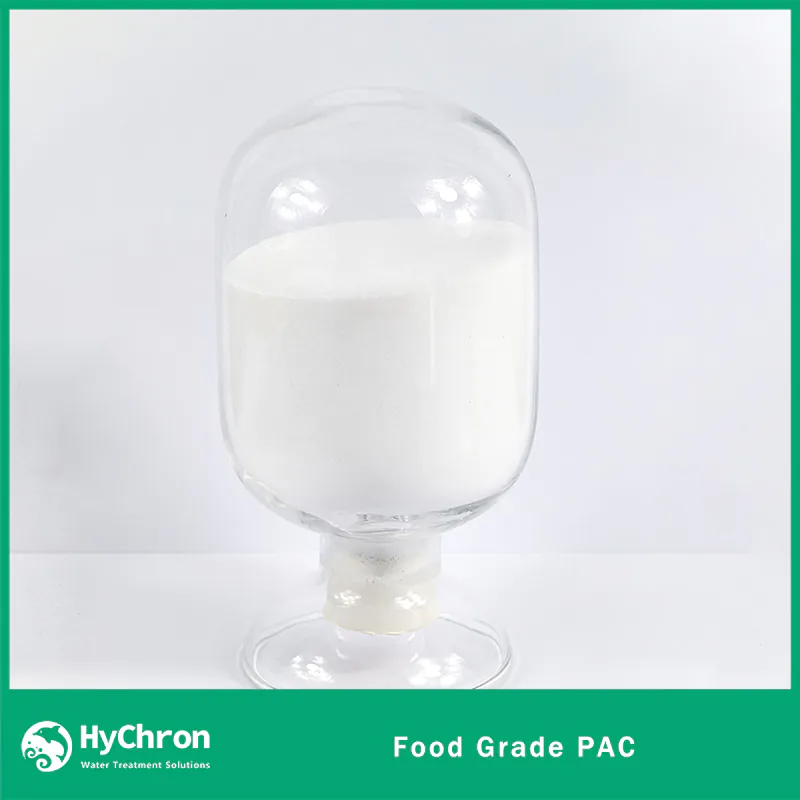Advantages
Chemical composition: Food-grade polyaluminum chloride is an inorganic polymer compound synthesized from aluminum salt and aluminum chloride, with colorless, tasteless, and non-toxic characteristics.
High purity: Its purity is very high, with an alumina content of over 30%. High purity means that the impurity content in the product is extremely low, which will not have a negative impact on the treated water quality.
High water purification ability: Food-grade PAC has extremely strong water purification ability, which can quickly and effectively remove impurities such as suspended solids, colloids, organic matter, heavy metal ions, etc. from water, and improve the clarity and transparency of water.
High Solubility: It dissolves readily in water, forming a stable solution that improves water treatment efficiency and minimizes sediment formation.
Low Residue: Compared to traditional coagulants, food-grade PAC produces significantly less residue, thanks to its high purity, high polymerization, and excellent solubility properties.
Production Methods
Spray drying:
Liquid raw materials – pressure filtration – spray tower spray drying – finished products
Drum drying:
Liquid raw materials – placement – drum drying – finished products
Features:
- AI₂O₃ content is high, ≥ 30%.
- Low basicity, only 50%. While the basicity of ordinary polyaluminum is about 90%.
- Water insoluble matter is less, only 0.3%. While ordinary polyaluminum has more than 2%.
- The color is white and pure, without any other heavy metals except AL +. The aqueous solution of the product is clear and transparent after dissolution, without color. While the aqueous solution of ordinary polyaluminum is yellow or brown in color.
- Low iron content, with the characteristics of low temperature and easy solubility.
Applications
- The pH value of food grade polyaluminum chloride is 6.5-7, and the pH value range it can adapt to is 5.0-9.
- It is used for the treatment of drinking water, industrial water supply, oilfield reinjection water, circulating cooling water and various highly polluted wastewater (such as urban wastewater, oily wastewater, printing and dyeing wastewater, papermaking wastewater, steel mill wastewater, etc.). White polyaluminum chloride replaces aluminum sulfate as a neutral sizing precipitant in the papermaking industry.
- Decolorizing and clarifying agent for sugar production.
- Used in various fields such as tanning, medicine, cosmetics, and precision casting.
- Scientific and technological research for high-tech.
Usage
For water treatment polyaluminum chloride, in order to achieve the best use effect and economic benefits, users can determine the optimum dosage through experiments according to different water quality conditions. Dilute the product to a concentration of about 5% according to the percentage content of AI₂O₃.
For the use of polyaluminum chloride for paper sizing, its usage is the same as that of aluminum sulfate, with a dosage of one-third of that of aluminum sulfate, calculated as 2% -3% for dry paper.
When used for decolorization and clarification in the sugar industry, first mix the product into a 3-5% aqueous solution (calculated based on AI₂O₃ content), then add it to the sucrose juice that needs to be decolorized, with a dosage of 5-10PPm.
The effect of combining food-grade polyaluminum chloride with polymer flocculants is better. For example, anionic polyacrylamide or cationic polyacrylamide can be dissolved with PAC polyaluminum chloride to form a composite flocculant, or PAC can be added to the water to be treated to form a coagulant, and then anionic polyacrylamide can be added to adsorb and bridge it into a large flocculant.
Storage and Handling
-
This product is acidic and should not be stored with alkaline substances (such as bleach, lime, etc.), otherwise the product will become ineffective.
-
The product should be stored indoors in a dry, ventilated, and cool place, and should not be damp. It is strictly prohibited to store it with flammable, corrosive, or toxic items.
-
With the packaging bag intact, the shelf life is one year.
Package
The solid raw materials are packaged in 25kg bags, with the inner layer made of plastic film and the outer layer made of plastic woven bags.







Reviews
There are no reviews yet.